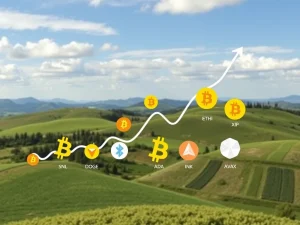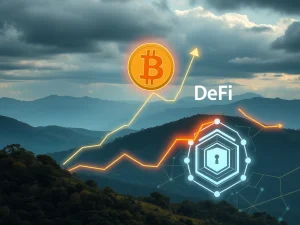Bitcoin Price Soars: How Global Liquidity Fuels the Rally

Curious why the Bitcoin price is on the move? Analysts point to a significant driver: accelerating global liquidity. This often-overlooked factor plays a crucial role in asset valuations, including cryptocurrencies. Understanding this relationship is key for anyone navigating the current market.
Global Liquidity: Bitcoin’s Silent Partner
According to experts like Raoul Pal, founder of Global Macro Investor, global liquidity growth is a primary force behind asset price movements, explaining a large percentage of Bitcoin’s action. While recession risks and geopolitical tensions exist, rising liquidity acts as a dominant positive influence. This close correlation, sometimes with a short lag, suggests that changes in the world’s money supply directly impact the cryptocurrency market.
Think of it simply: when there’s more money flowing in the global system, more of it tends to find its way into various assets, including Bitcoin. This is especially true when traditional investments offer low returns or currencies face devaluation pressures. Pal notes that currency debasement and inflation create a ‘hidden tax,’ making assets like Bitcoin, with strong historical returns, attractive.
What Drives Global Liquidity?
At a fundamental level, global liquidity expands due to increasing debt levels across many countries. This structural trend suggests long-term growth. However, shorter-term fluctuations are influenced by specific forces. Michael Howell, author of “Capital Wars,” identifies key drivers:
- The US Federal Reserve’s monetary policy decisions.
- The People’s Bank of China (PBoC) actions.
- Lending activity by banks, particularly in collateral markets.
Indirect factors also play a role after a delay, including the global business cycle, oil prices, dollar strength, and bond market volatility. A weaker global economy and a softer dollar can boost liquidity, while rising bond volatility can restrict credit.
Will Global Liquidity Continue to Rise?
Michael Howell suggests global liquidity moves in cycles, often around five years long. He projects the current cycle to peak around mid-2026. Recent growth stems partly from a weakening global economy, which pressures central banks to ease monetary policy. The PBoC has already taken steps to inject liquidity.
The US Federal Reserve faces a dilemma: continue fighting inflation or support a fragile financial system. While rates were recently held steady, pressure for easing exists. However, economic uncertainty increases US Treasury yields and bond market volatility, which can tighten credit conditions. Despite potential future headwinds, liquidity may still expand through 2025.
The Link Between Liquidity, Central Banks, and Inflation
The actions of central banks like the Fed and PBoC are central to liquidity levels. Their decisions on interest rates and asset purchases directly impact the money supply. When central banks inject liquidity, it can be seen as a form of monetary inflation, increasing the total amount of money in the system relative to goods and services.
This environment of persistent monetary inflation, driven by the ‘more liquidity’ policy response, historically benefits assets seen as hedges against devaluation, such as gold, real estate, and Bitcoin. The prospect of continued liquidity expansion provides a favorable backdrop for these assets.
Connecting Liquidity Cycles and Bitcoin’s Halving
Interestingly, Michael Howell’s projected liquidity cycle peak in late 2025 or mid-2026 roughly aligns with the typical timeframe for Bitcoin’s price peak following its four-year halving cycle (the most recent halving was in April 2024). If historical patterns repeat, the convergence of these two cycles could precede a significant market event for Bitcoin.
In conclusion, while various factors influence the Bitcoin price, the growth of global liquidity stands out as a major driver. Analyzed through market analysis, the actions of central banks like the Fed and PBoC, and the structural forces leading to monetary expansion and inflation, the outlook for liquidity suggests continued support for risk assets, potentially propelling Bitcoin higher in the coming years, though market cycles involve inherent volatility and risks.










